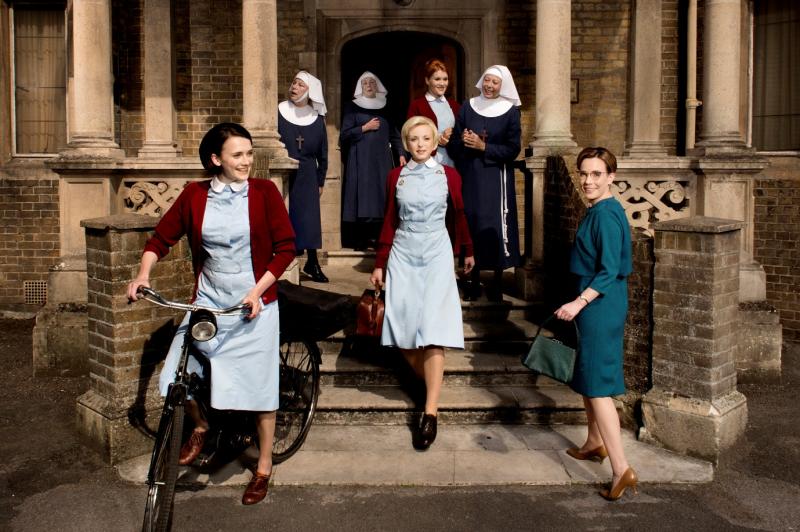Released on: 11 February 2015
We hear from some of the cast and crew of Call the Midwife as they talk about themes from the new series and their thoughts on giving birth in the 1950s compared to today
Call the Midwife follows the lives of a group of midwives and the families they care for in the east end of London during the 1950s. On Sunday nights, you can watch episodes from the fourth series. “My own mantra for this series has been ‘The world is changing one woman at a time’,” says Heidi Thomas, creator, writer and executive producer of the programme.
“I felt I couldn’t ignore the fact that feminism was just starting to bubble under, even though it scarcely had a name in 1960. There would be no mass movement until much later in the decade, but it all began with the women we meet in Call the Midwife – the mothers, the young girls and, of course, the midwives themselves. We see women start to question their experiences, and struggle with society’s expectations of them. There is a clear sense that they want to make their own choices, but are not always free to do so.

“As ever, we continue to tell stories about pregnancy and childbirth. Choice remains a theme – hospital or home birth? Breast or bottle feeding? And we do see changes happening – mothers aren’t forced onto their backs in labour, and fathers have a much firmer foot in the door,” says Heidi. “We also sustain our tradition of examining lives that are lived on the margins of society – we meet people suffering with mental health conditions, prostitutes, a young offender, and a homeless family.”
Inspiring stories of birth and human interaction
The drama was originally inspired by the best-selling memoirs of Jennifer Worth, a British midwife who worked in the east end of London in the 1950s. How does Heidi explore and research stories for the series? “I always do all my own research whether it’s social, medical or specifically to do with midwifery. For example, many of my stories for series four were inspired by a 1960 medical report for Poplar [the area where the drama is set], which I found in a museum archive. It was full of simple statistics about cancer, dysentery, birth and stillbirth, a plague of rats, care of the elderly; it captured the very stuff of life.”
The storylines also rely on input and direction from the show’s midwifery advisor, Terri Coates, a practising midwife and midwifery lecturer of over 40 years. “I’m sent the storylines at an early stage and I help ensure that they have clinical credibility. I always refer them to the appropriate professional if it’s beyond my scope of practice.”
So what's it like working on a TV set compared to Terri’s job in the NHS? “If something’s not quite right on set then we can do it again – unlike working for the NHS,” she says. “I have to work very hard in the NHS to make sure women get the birth that they want the first time. But on set we make sure we get the birth that’s right for the script and we get lots of chances to do that. I take great pride in making midwifery look right - helping the actresses look like midwives and teaching them aspects of midwifery that can be demonstrated to the public to make them look like competent midwives.”
How do they film the birth scenes?
Of course, giving birth is a major part of the drama; how do the actresses find filming these incredibly emotional scenes? “The process of the births is a very tightly choreographed set up,” explains Emerald Fennell who plays midwife Patsy Mount. “My first birth on set was terrifying and it was quite a complicated one because the mum had to give birth on the floor of her sitting room. The newborns are babies under 14 days old so they are incredibly tiny and we have to cover them in grape seed oil in order to make it look like they’ve just been given birth to. That obviously makes them incredibly slippery! It is nerve-wracking because you feel an enormous responsibility.”
The role midwives play in a woman’s journey through pregnancy and birth is a key part of the relationships that develop in each episode. For Terri allowing people to have a better understanding of midwifery, as well as birth and pregnancy, is really important. “I believe people do have a better understanding of midwifery through the show. It has given people a chance to talk about birth and pregnancy education,” she says.
Comparing the 1950s to now
It’s hard not to compare life in the 1950s to now; particularly when so many storylines are still relevant today. Today’s newspaper headlines frequently comment on issues, such as the shortage of midwives, the state of the NHS and maternity services for women.
“Being part of the show really reminds you why the NHS started. I know we bemoan it and there are things that are wrong but we can’t lose it. It’s a real credit to the welfare state,” says Victoria Yeates who plays Sister Winifred.
Continuity of care is still important
One thing that was hugely positive in the 1950s was the continuity of care women received from their midwives. “There was a strong relationship between the midwife and the mother over a sustained period of time so they built up a friendship and trust,” says Helen George who plays midwife Trixie Franklin. “That’s a really valuable thing but it’s so sad that it doesn’t seem to be attainable these days. Population and communities were so much smaller then.”
Bryony Hannah who plays Cynthia Miller adds: “I just love the idea that the midwives were in the community riding around on bicycles, it feels like that never happens these days. But we still have a network of amazing people keeping our mothers and children safe.”
NCT’s roots, like Call the Midwife, date back to the 1950s, as we’ve been campaigning on behalf of parents and supporting them since 1956. We have evolved as an organisation, as society has in the last 50 years, but continuity of care is one thing that we just as strongly advocate and believe in now as we did in 1956. And with good reason, we know that women are more likely to mention concerns to someone they trust and it’s easier for midwives to spot a problem in someone they have come to know, as we’ve seen in Call the Midwife. Research also shows that women today who receive continuity of care during and after pregnancy are less likely to give birth prematurely and have fewer complications.
Call the Midwife is a drama that shows us how much maternity services have changed but also what we might learn again in terms of helping women today have safe, comfortable and happy births.
Finally, we have to ask: what’s it like to wear a nun’s habit? Judy Parfitt who plays Sister Monica Joan admits: “It’s not comfortable and you can’t hear because there are six layers of material covering your ears!”
Watch Call the Midwife on BBC One on Sunday nights at 8pm



